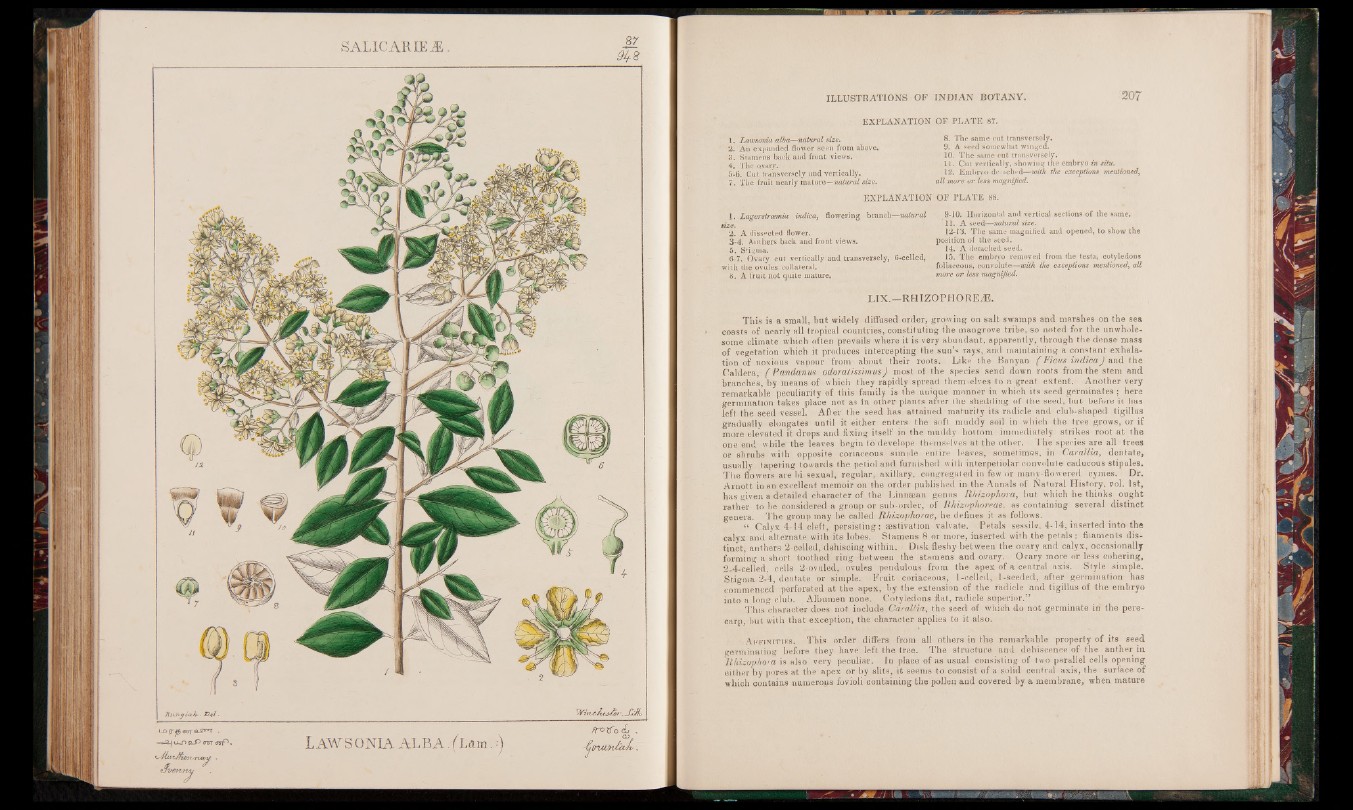
S AL ICAR IE Æ
La w s o n ia a l b a Y Lam
EXPLANATION
1. Lawsonia alba■—natural size.
2. An expanded flower seen from above.
3. Stamens back and front views.
4. The ovary.
5-6. Cut transversely and vertically.
7. The fruit nearly mature—natural size.
EXPLANATION
1. Lagerstrcemia indica, flowering branch—natural
size.
2. A dissected flower.
3-4. Anthers back and front views.
5. Stigma.
3-7. Ovary cut vertically and transversely, 6-celled,
with the ovules collateral.
8. A fruit not quite mature.
OF PLATE 87.
8. The same cut transversely.
9. A seed somewhat winged.
10. The same cut transversely.
11. Cut vertically, showing the embryo in situ.
12. Embryo detached—with the exceptions mentioned,
all more or less magnified.
OF PLATE 88.
9-10. Horizontal and vertical sections of the same.
11. A seed—natural size.
12-13. The same magnified and opened, to show the
position of the seed.
14. A detached seed.
15. The embryo removed from the testa, cotyledons
foliaceous, convolute—with the exceptions mentioned, all
more or less magnified.
LIX.—RHIZOPHOREA3.
This is a small, but widely diffused order, growing on salt swamps and marshes on the sea
coasts of nearly all tropical countries, constituting the mangrove tribe, so noted for the unwholesome
climate which often prevails where it is very abundant, apparently, through the dense mass
of vegetation which it produces intercepting the sun’s rays, and maintaining a constant exhalation
of noxious vapour from about their roots. Like the Banyan ( Ficus in d ic a J and the
Caldera, ( P a ndanus odoratissimus) most of the species send down roots from the stem and
branches, by means of which they rapidly spread themselves to a great extent. Another very
remarkable peculiarity of this family is the unique manner in which its seed germinates ; here
germination takes place not. as in other plants after the shedding of the seed, but before it has
left the seed vessel. After the seed has attained maturity its radicle and club-shaped tigillus
gradually elongates until it either enters the soft muddy soil in which the tree grows, or if
more elevated it drops and fixing itself in the muddy bottom immediately strikes root at the
one end while the leaves begin to develope themselves at the other. The species are all trees
or shrubs with opposite coriaceous simple entire leaves, sometimes, in Carallia, dentate,
usually tapering towards the petiol and furnished with interpetiolar convolute caducous stipules.
The flowers are bi sexual, regular, axillary, congregated in few or many-flowered cymes. Dr.
Arnott in an excellent memoir on the order published in the Annals of Natural History, vol. 1st,
has given a detailed character of the Linnaean genus R h izophora, but which he thinks ought
rather to be considered a group or sub-order, of Rhizophoreae, as containing several distinct
genera. The group may be called Rhizo p h o ra e, he defines it as follows.
“ Calyx 4-14 cleft, persisting: aestivation valvate. Petals sessile. 4-14, inserted into the
calyx and alternate with its lobes. Stamens 8 or more, inserted with the petals : filaments distinct,
anthers 2-celled, dehiscing within. Disk fleshy between the ovary and calyx, occasionally
forming a short toothed ring between the stamens and ovary. Ovary more or less cohering,
2-4-celled, cells 2-ovuled, ovules pendulous from the apex of a central axis. Style simple.
Stigma 2-4, dentate or simple. Fruit coriaceous, 1-celled, 1-seeded, after germination has
commenced perforated at the apex, by the extension of the radicle and tigillus of the embryo
into a long club. Albumen none. Cotyledons flat, radicle superior.”
This character does not include Cara llia , the seed of which do not germinate in the pere-
earp, but with that exception, the character applies to it also.
A kfinitiks. This order differs from all others in the remarkable property of its seed
germinating before they have left the tree. The structure and dehiscence of the anther in
Rhizophora is also very peculiar. In place of as usual consisting of two parallel cells opening
either by pores at the apex or by slits, it seems to consist of a solid central axis, the surface of
which contains numerous fovioli containing the pollen and covered by a membrane, when mature